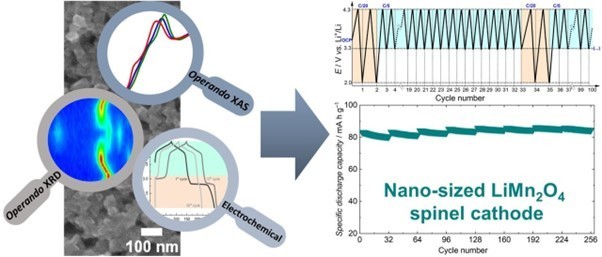Understanding the (de-)lithiation mechanism of nano-sized LiMn2O4 allows achieving long-term cycling stability
We report an in-depth investigation of the local atomic geometry, electronic and crystallographic structure evolution of nano-sized LiMn2O4 using operando XAS and XRD to shed light on (de-)lithiation mechanism when cycled in wide voltage range of 2.0 to 4.3 V vs Li+/Li. Leveraging on these findings, a novel electrochemical cycling protocol, with periodic deep discharge, yields superior electrochemical performance cycled in the range of 3.3 to 4.3 V exhibiting an excellent structure cyclability and an unprecedented increase in the specific capacity upon long cycling.
Lithium-ion battery (LIB) remains the most widely used technology for portable electronic, electric vehicle and as backup power, connected to the grid when electricity is produced from renewable sources. Despite the substantial progress in this area over the last years, the development of advanced LIBs to meet safety, low cost, environmentally friendly with the desirable stable power and energy densities is one of the most important challenges of nowadays modern electrochemistry. In this context, LiMn2O4 spinel-type has received continuous and considerable attention as cathode material for LIB applications. Besides its low-cost and being abound non-toxic material, LiMn2O4 is a high voltage cathode with the ability of accommodating two Li+ per unit cell resulting in 296 mAh g–1 as theoretical specific capacity. Unfortunately, LiMn2O4 and other transition metal cathode materials have been observed to suffer from irreversible phase transformations responsible for the capacity fading upon long cycling. Particularly, for the LiMn2O4, one of the causes of low cyclability is related to the presence of the Jahn-Teller distortion, which is a phase change from cubic to tetragonal when the second Li+ is intercalated. Such Jahn-Teller distortion destabilizes the host structure of cathode material, resulting in a large volume change.
Synthesis of nanostructured electrode materials represents one of the most attractive strategies to enhance battery performance including cycling life and rate capability. Besides the better Li+ diffusion consequence of the short diffusion pathway, nano-sized particles with respect to micron-sized can better accommodate the strain caused by the volume change during cycling which cause cracking, fracture, and pulverization of the active particles during cycling and rapid fading of the cell.
In this study we exploited the capability of operando XAS and XRD to shed light on the (de-)lithiation processes within nano-sized and micron-sized LiMn2O4 spinel and to elucidate the mechanism and the role playing the Jahn-Teller distortion in two different cycling voltage ranges. By monitoring the local atomic geometry change, the electronic and crystallographic structure evolution, we demonstrated the contrasting Li diffusivity of nano-sized and micron-sized spinels. In the nano-sized we observed that is easier to intercalate Li during discharge, while in the micron-sized is easier to de-intercalate Li+ upon charge. Furthermore, when nano-sized spinel is cycled in the wide voltage range 2.0 and 4.3 V, clear evidence of a significant Jahn-Teller distortion occurring during deep discharge at low potential which is reversible during charging to 3.3 V. We additionally find that in the nano-sized spinel, the deep discharge at 2.0 V to form the Jahn-Teller distortion enhances the Li+ deintercalation in the further charges. Finally, based on the electronic and atomic geometric structure studies, a cycling protocol has been proposed for the nano-sized LiMn2O4 spinel particles to achieve an optimal electrochemical performance. The protocol consists in cycling the cathodes repetitively in two different voltage range: 2 cycles at C/20 rate in a wide range charging to 4.3 V and discharging until 2.0 V (where the Jahn-Teller distortion takes place), follow by 30 cycles between 3.3 and 4.3 V at C/5 rate. The nano-sized spinel cathode recovered the capacity lost after being cycled only twice in the wide voltage range and presents more defined plateaus in the charge/discharge profiles indicating an improvement of Li+ diffusivity after deep discharge. Furthermore, this protocol led to increased specific capacity values in long cycling performance with a Coulombic efficiency higher than 99% in the voltage range of 3.3 V to 4.3 V for the nano-sized spinel LiMn2O4 compared to the micron-sized counterpart. Our findings exemplify the structural flexibility of the Li-rich nano-sized spinel and its excellent potential in long term cycling stability in half cell batteries.
